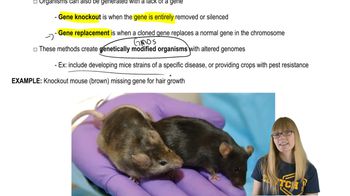Table of contents
- 1. Introduction to Genetics51m
- 2. Mendel's Laws of Inheritance3h 37m
- 3. Extensions to Mendelian Inheritance2h 41m
- 4. Genetic Mapping and Linkage2h 28m
- 5. Genetics of Bacteria and Viruses1h 21m
- 6. Chromosomal Variation1h 48m
- 7. DNA and Chromosome Structure56m
- 8. DNA Replication1h 10m
- 9. Mitosis and Meiosis1h 34m
- 10. Transcription1h 0m
- 11. Translation58m
- 12. Gene Regulation in Prokaryotes1h 19m
- 13. Gene Regulation in Eukaryotes44m
- 14. Genetic Control of Development44m
- 15. Genomes and Genomics1h 50m
- 16. Transposable Elements47m
- 17. Mutation, Repair, and Recombination1h 6m
- 18. Molecular Genetic Tools19m
- 19. Cancer Genetics29m
- 20. Quantitative Genetics1h 26m
- 21. Population Genetics50m
- 22. Evolutionary Genetics29m
18. Molecular Genetic Tools
Genetic Cloning
Problem 11
Textbook Question
Injection of double-stranded RNA can lead to gene silencing by degradation of RNA molecules complementary to either strand of the dsRNA. Could RNAi be used in gene therapy for a defect caused by a recessive allele? A dominant allele? If so, what might be the major obstacle to using RNAi as a therapeutic agent?
 Verified step by step guidance
Verified step by step guidance1
Step 1: Understand the mechanism of RNA interference (RNAi). RNAi involves the introduction of double-stranded RNA (dsRNA) that is complementary to a target mRNA, leading to its degradation and thus silencing the expression of that gene. This process can reduce or eliminate the production of the protein encoded by the target gene.
Step 2: Consider the application of RNAi in gene therapy for a recessive allele defect. Since recessive disorders typically result from loss-of-function mutations, the defective allele usually produces little or no functional protein. RNAi, which silences gene expression, would not be beneficial here because the problem is insufficient protein rather than excess or harmful protein.
Step 3: Consider the application of RNAi in gene therapy for a dominant allele defect. Dominant disorders often arise from gain-of-function mutations or dominant-negative effects, where the mutant allele produces a harmful protein. RNAi could be used to selectively silence the mutant allele's mRNA, reducing the harmful protein's production and potentially alleviating disease symptoms.
Step 4: Identify the major obstacle in using RNAi therapeutically. One key challenge is achieving allele-specific silencing—RNAi must target only the mutant allele without affecting the normal allele to avoid unwanted side effects. Designing RNAi molecules that discriminate between alleles differing by only a single nucleotide can be difficult.
Step 5: Consider additional obstacles such as delivery methods, stability of RNAi molecules in the body, off-target effects, and immune responses. Efficient and safe delivery to the correct cells and tissues is critical for successful RNAi-based gene therapy.
 Verified video answer for a similar problem:
Verified video answer for a similar problem:This video solution was recommended by our tutors as helpful for the problem above
Video duration:
4mPlay a video:
Was this helpful?
Key Concepts
Here are the essential concepts you must grasp in order to answer the question correctly.
RNA Interference (RNAi) Mechanism
RNAi is a biological process where double-stranded RNA triggers the degradation of complementary messenger RNA, effectively silencing specific genes. This mechanism can selectively reduce the expression of target genes, making it a powerful tool for regulating gene activity in research and therapy.
Recommended video:
Guided course

RNA Interference
Genetic Basis of Recessive and Dominant Alleles
Recessive alleles cause a phenotype only when both copies are defective, while dominant alleles express their effect even if only one copy is mutated. Understanding this distinction is crucial for determining whether gene silencing via RNAi can compensate for or suppress the defective gene product.
Recommended video:
Guided course

Variations on Dominance
Challenges of RNAi in Gene Therapy
Major obstacles in using RNAi therapeutically include delivery to target cells, specificity to avoid off-target effects, and ensuring sustained gene silencing without triggering immune responses. These challenges must be addressed to safely and effectively use RNAi for treating genetic disorders.
Recommended video:
Guided course

Transgenic Organisms and Gene Therapy
Related Videos
Related Practice
Textbook Question
Chimeric gene-fusion products can be used for medical or industrial purposes. One idea is to produce biological therapeutics for human medical use in animals from which the products can be easily harvested—in the milk of sheep or cattle, for example. Outline how you would produce human insulin in the milk of sheep.
399
views


